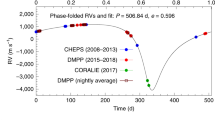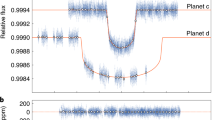Abstract
To put the Solar System’s terrestrial planets in context, the detection and characterization of low-mass exoplanets is important but challenging. The Dispersed Matter Planet Project targets stars with anomalously low Ca ii H and K chromospheric emission, indicative of circumstellar absorbing gas. Here we report high-precision, high-cadence radial-velocity measurements of the F8V star DMPP-1 (HD 38677). These were motivated by depressed Ca ii H and K line cores indicative of short-period, ablating planets producing circumstellar gas. We find a compact planetary system with orbital periods of about 2.9–19 days, comprising three super-Earth-mass planets (about 3–10 M⊕) and one Neptune-mass planet (about 24 M⊕). The irradiated super-Earths may be remnant cores of giant planets after mass loss while crossing the Neptune desert. A priori inferences about the presence of short-period planets enabled the efficient discovery of the DMPP-1 planets. We anticipate informative follow-up characterization studies.
This is a preview of subscription content, access via your institution
Access options
Access Nature and 54 other Nature Portfolio journals
Get Nature+, our best-value online-access subscription
$29.99 / 30 days
cancel any time
Subscribe to this journal
Receive 12 digital issues and online access to articles
$119.00 per year
only $9.92 per issue
Buy this article
- Purchase on Springer Link
- Instant access to full article PDF
Prices may be subject to local taxes which are calculated during checkout






Similar content being viewed by others
Data availability
The data that support the plots within this paper and other findings of this study are available from the corresponding author upon reasonable request. All RV data, collected under ESO programmes 096.C-0876(A) and 098.C-0269(A), 098.C0499(A), 098.C0269(B), 099.C-0798(A) and 0100.C-0836(A), are publicly available from the ESO archive (http://archive.eso.org).
Change history
13 March 2020
A Correction to this paper has been published: https://doi.org/10.1038/s41550-020-1074-7
References
Vidal-Madjar, A. et al. An extended upper atmosphere around the extrasolar planet HD209458b. Nature 422, 143–146 (2003).
Hebb, L. et al. WASP-12b: the hottest transiting extrasolar planet yet discovered. Astrophys. J. 693, 1920–1928 (2009).
Fossati, L. et al. Metals in the exosphere of the highly irradiated planet WASP-12b. Astrophys. J. 714, L222–L227 (2010).
Haswell, C. A. et al. Near-ultraviolet absorption, chromospheric activity, and star-planet interactions in the WASP-12 system. Astrophys. J. 760, 79 (2012).
Haswell, C. A. WASP-12b: a mass-losing extremely hot Jupiter. In Handbook of Exoplanets (eds Deeg, H. J. & Belmonte, J. A.) 97 (Springer International Publishing, 2017).
Rappaport, S. et al. Possible disintegrating short-period super-Mercury orbiting KIC 12557548. Astrophys. J. 752, 1 (2012).
Staab, D. Enshrouded Exoplanetary Systems. PhD thesis, The Open University (2018).
Fossati, L. et al. Absorbing gas around the WASP-12 planetary system. Astrophys. J. 766, L20 (2013).
Haswell, C. A.et al. Dispersed Matter Planet Project discoveries of ablating planets orbiting nearby bright stars. Nat. Astron. https://doi.org/10.1038/s41550-019-0973-y (2019).
Staab, D. et al. SALT observations of the chromospheric activity of transiting planet hosts: mass-loss and star-planet interactions. Mon. Not. R. Astron. Soc. 466, 738–748 (2017).
Arriagada, P. Chromospheric activity of southern stars from the Magellan Planet Search Program. Astrophys. J. 734, 70 (2011).
Minniti, D. et al. Low-mass companions for five solar-type stars from the Magellan Planet Search Program. Astrophys. J. 693, 1424–1430 (2009).
Bernstein, R., Shectman, S. A., Gunnels, S. M., Mochnacki, S. & Athey, A. E. MIKE: a double echelle spectrograph for the Magellan telescopes at Las Campanas Observatory. Proc. SPIE 4841, 1694–1704 (2003).
Mayor, M. et al. Setting new standards with HARPS. Messenger 114, 20–24 (2003).
Anglada-Escudé, G. & Butler, R. P. The HARPS-TERRA project. I. Description of the algorithms, performance, and new measurements on a few remarkable stars observed by HARPS. Astrophys. J. Supp. 200, 15 (2012).
Anglada-Escudé, G. et al. A dynamically-packed planetary system around GJ 667C with three super-Earths in its habitable zone. Astron. Astrophys. 556, A126 (2013).
Anglada-Escudé, G. et al. A terrestrial planet candidate in a temperate orbit around Proxima Centauri. Nature 536, 437–440 (2016).
Tuomi, M., Jones, H. R. A., Barnes, J. R., Anglada-Escudé, G. & Jenkins, J. S. Bayesian search for low-mass planets around nearby M dwarfs—estimates for occurrence rate based on global detectability statistics. Mon. Not. R. Astron. Soc. 441, 1545–1569 (2014).
Vaughan, A. H., Preston, G. W. & Wilson, O. C. Flux measurements of CA II H and K emission. Publ. Astron. Soc. Pac. 90, 267–274 (1978).
Rein, H. & Spiegel, D. S. IAS15: a fast, adaptive, high-order integrator for gravitational dynamics, accurate to machine precision over a billion orbits. Mon. Not. R. Astron. Soc. 446, 1424–1437 (2015).
Rein, H. & Liu, S.-F. REBOUND: an open-source multi-purpose N-body code for collisional dynamics. Astron. Astrophys. 537, A128 (2012).
Dawson, R. I. Tightly packed planetary systems. In Handbook of Exoplanets (eds Deeg, H. J. & Belmonte, J. A.) (Springer International Publishing, 2017).
Tremaine, S. The statistical mechanics of planet orbits. Astrophys. J. 807, 157 (2015).
Moriarty, J. & Ballard, S. The Kepler dichotomy in planetary disks: linking Kepler observables to simulations of late-stage planet formation. Astrophys. J. 832, 34 (2016).
Dawson, R. I. Time domain challenges for exoplanets. Am. Astron. Soc. 227, 310.03 (2016).
Agol, E. & Fabrycky, D. C. Transit-timing and duration variations for the discovery and characterization of exoplanets. In Handbook of Exoplanets (eds Deeg, H. J. & Belmonte, J. A.) (Springer International Publishing, 2017).
Sigurdsson, H. et al. (eds) The Encyclopedia of Volcanoes 2nd edn (Elsevier Science & Technology, 2015).
Vidotto, A. A. et al. Characterization of the HD 219134 multi-planet system II. Stellar-wind sputtered exospheres in rocky planets b & c. Mon. Not. R. Astron. Soc. 481, 5296–5306 (2018).
Mazeh, T., Holczer, T. & Faigler, S. Dearth of short-period Neptunian exoplanets: a desert in period-mass and period-radius planes. Astron. Astrophys. 589, A75 (2016).
Fossati, L. et al. The effect of ISM absorption on stellar activity measurements and its relevance for exoplanet studies. Astron. Astrophys. 601, A104 (2017).
Soto, M. G. & Jenkins, J. S. Spectroscopic Parameters and atmosphEric ChemIstriEs of Stars 715 (SPECIES). I. Code description and dwarf stars catalogue. Mon. Not. R. Astron. Soc. 615, A76 (2018).
Sneden, C., Bean, J., Ivans, I., Lucatello, S. & Sobeck, J. MOOG: LTE line analysis and spectrum synthesis. Astrophys. Source Code Library 1202.009 (2012).
Castelli, F. & Kurucz, R. L. New grids of ATLAS9 model atmospheres. Preprint at https://arxiv.org/abs/astro-ph/0405087 (2004)
Morton, T. D. isochrones: stellar model grid package. Astrophys. Source Code Library 1503.010 (2015).
Dotter, A. MESA Isochrones and Stellar Tracks (MIST) 0: methods for the construction of stellar isochrones. Astrophys. J. 222, 8 (2016).
Pepe, F. et al. The HARPS search for Earth-like planets in the habitable zone. I. Very low-mass planets around HD 20794, HD 85512, and HD 192310. Astron. Astrophys. 534, A58 (2011).
Gilliland, R. L. et al. Kepler-68: three planets, one with a density between that of Earth and ice giants. Astrophys. J. 766, 40 (2013).
Jackson, B., Greenberg, R. & Barnes, R. Tidal evolution of close-in extrasolar planets. Astrophys. J. 678, 1396–1406 (2008).
Baluev, R. V. Accounting for velocity jitter in planet search surveys. Mon. Not. R. Astron. Soc. 393, 969–978 (2009).
Baluev, R. V. Assessing the statistical significance of periodogram peaks. Mon. Not. R. Astron. Soc. 385, 1279–1285 (2008).
Butler, R. P. et al. The LCESr HIRES/Keck Precision Radial Velocity Exoplanet Survey. Astron. J. 153, 208 (2017).
Gillon, M. et al. Two massive rocky planets transiting a K-dwarf 6.5 parsecs away. Nat. Astron. 1, 0056 (2017).
Acknowledgements
This work is based on observations collected at the European Organisation for Astronomical Research in the Southern Hemisphere under ESO programmes 096.C-0876(A) and 098.C-0269(A), 098.C0499(A), 098.C0269(B), 099.C-0798(A) and 0100.C-0836(A). D.S. was supported by an STFC studentship. C.A.H. and J.R.B. were supported by STFC Consolidated Grants ST/L000776/1 and ST/P000584/1. G.A.-E. was supported by STFC Consolidated Grant ST/P000592/1. J.S.J. acknowledges support by FONDECYT grant 1161218 and partial support from CONICYT project Basal AFB-170002. M.R.D. acknowledges the support of CONICYT-PFCHA/Doctorado Nacional-21140646, Chile, and project Basal AFB-170002. These results were based on observations awarded by ESO using HARPS. This research has made use of the SIMBAD data base, operated at CDS, Strasbourg, France.
Author information
Authors and Affiliations
Contributions
D.S. performed target selection, and contributed to writing of proposals, making figures, initial RV analyses and technical details of the paper. C.A.H. plans and leads all aspects of the DMPP collaboration, secured the funding, and wrote the proposals and much of the paper. J.R.B. contributed to proposals, performed final RV analyses, wrote the initial paper draft and the technical sections and made the figures. G.A.-E. provided software and expertise. L.F. contributed to the analysis and proposal writing. J.S.J. and M.G.S. provided expertise on stellar activity, the log R′HK metric and contributed stellar parameter analyses. D.S., C.A.H., J.R.B., J.P.J.D., J.C. and M.R.D. performed observations with HARPS. All authors were given the opportunity to review the results and comment on the manuscript.
Corresponding author
Ethics declarations
Competing interests
The authors declare no competing interests.
Additional information
Peer review information Nature Astronomy thanks Teruyuki Hirano for their contribution to the peer review of this work.
Publisher’s note Springer Nature remains neutral with regard to jurisdictional claims in published maps and institutional affiliations.
Supplementary information
Supplementary Information
Supplementary text, Supplementary Table 1, Supplementary references, Supplementary Figs. 1–4.
Rights and permissions
About this article
Cite this article
Staab, D., Haswell, C.A., Barnes, J.R. et al. A compact multi-planet system around a bright nearby star from the Dispersed Matter Planet Project. Nat Astron 4, 399–407 (2020). https://doi.org/10.1038/s41550-019-0974-x
Received:
Accepted:
Published:
Issue Date:
DOI: https://doi.org/10.1038/s41550-019-0974-x
This article is cited by
-
Exoplanet mass estimation for a sample of targets for the Ariel mission
Experimental Astronomy (2022)
-
Dispersed Matter Planet Project discoveries of ablating planets orbiting nearby bright stars
Nature Astronomy (2019)
-
An ablating 2.6 M⊕ planet in an eccentric binary from the Dispersed Matter Planet Project
Nature Astronomy (2019)



